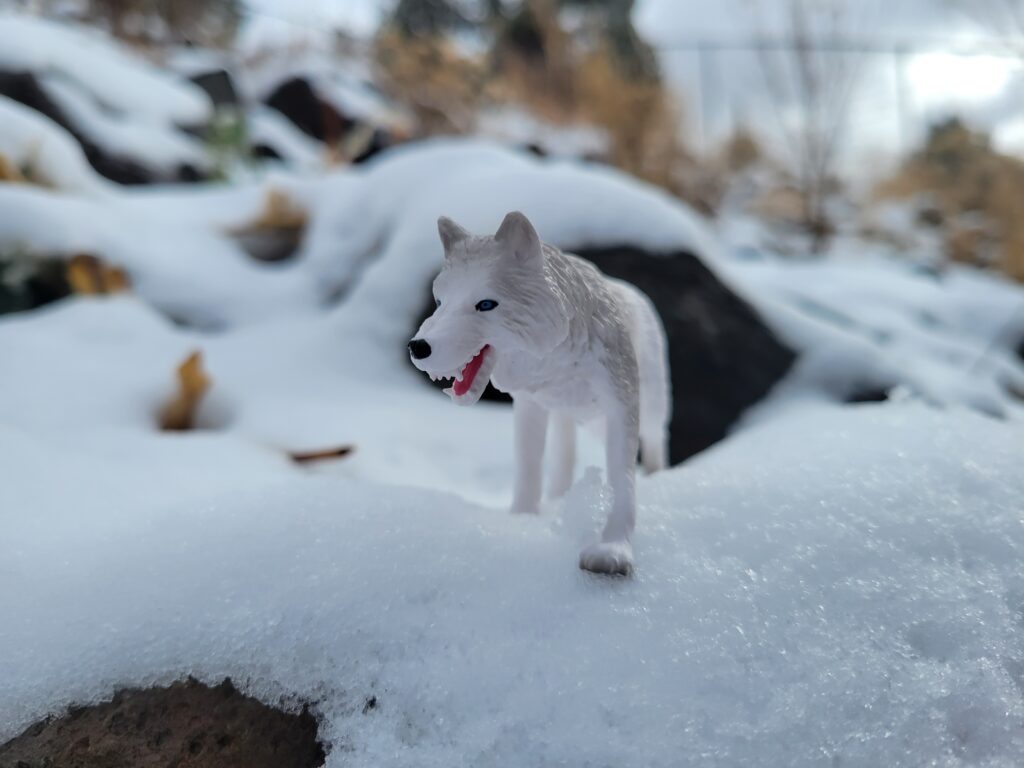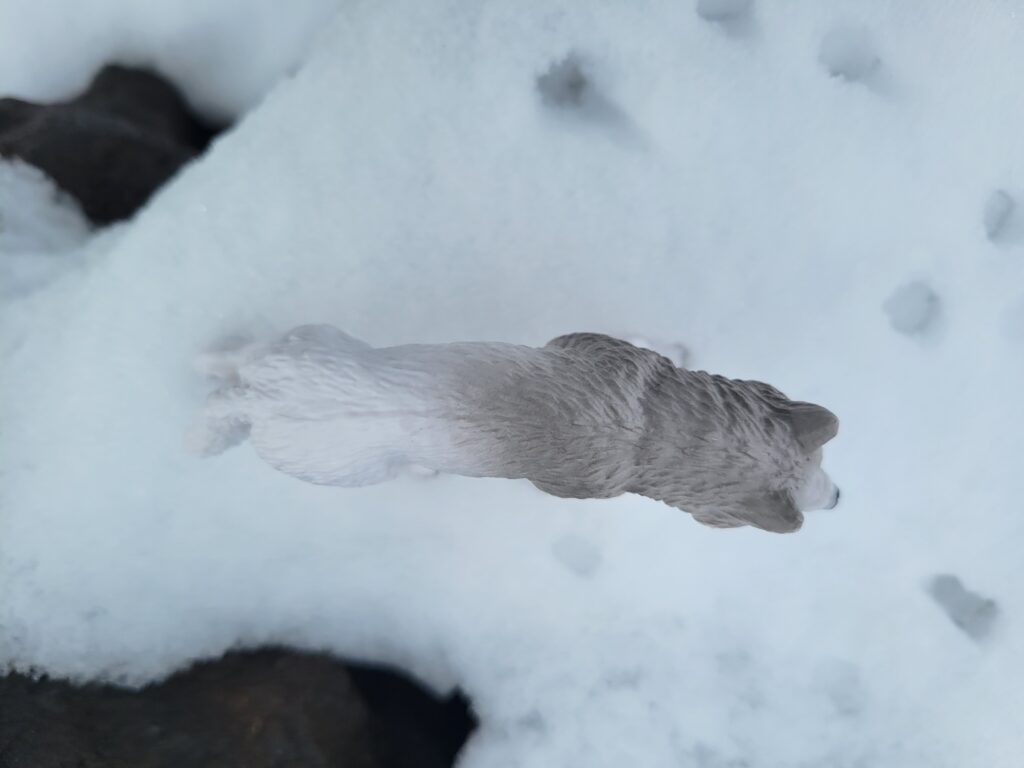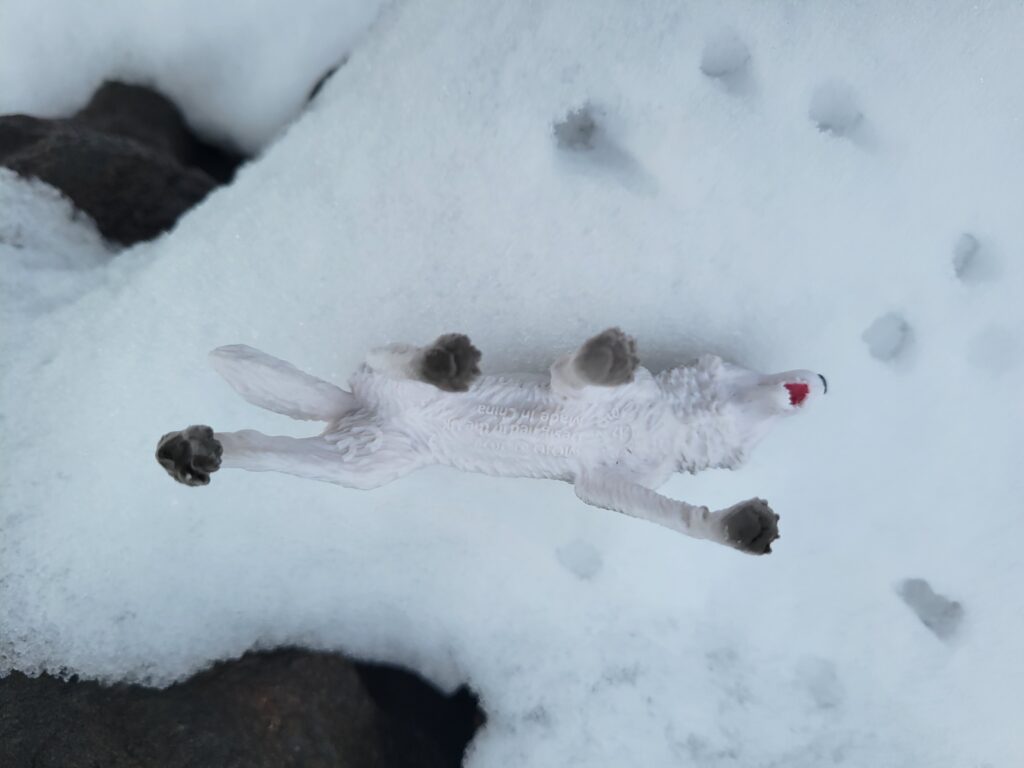Happy holidays to all! I hope this latest post finds you in the holiday spirit, or at the very least an “Arctic animal appreciation” one. This post will focus on the Mojö Fun Arctic wolf #381052 released in 2022. The model itself is the first of its kind for Mojö, having only released one other wolf species, and the most common (read “generic”) of them at that. This release is unique for a few reasons, mainly being that this is one of the quintessential species for the extreme Arctic! Now let us get into the article.

The Arctic wolf is a population of wolves that inhabit the northernmost climes of the globe; generally, north of the Arctic tree line. The tundra of the Arctic is an extreme habitat and one that fairly few animals have been able to adapt to. But of course, the highly adaptable and opportunistic canine clan was one of the few to do so. This group of animals differs from the mainland population of North American gray wolves in a few ways, albeit very subtle differences. These wolves are smaller, generally have even thicker winter coats, graduate from a muddy looking pelage as young animals into a pure white ensemble, have narrower braincases, and larger carnassial teeth than their mainland cousins. Behaviorally, these animals are in large part the same. There are some seasonal differences such as small migrations to follow their restricted food source of musk oxen or caribou that their southern cousins aren’t required to undertake. And their pack dynamic is often viewed as even more strict and exacting; this is often thought to be because of the higher stakes for survival in such an unforgiving environment. They are also known to be more aggressive to humans. While human cohabitation is usually a non-issue, in the cases where paths do intermingle, the wolves have shown very little avoidance. In some extreme cases they have attacked humans; however, in nearly every case it was proven to be an animal suffering from disease such as rabies. There are a few cases also of wolf packs attacking polar bear cubs successfully. However, most often, any interaction with them is limited to brief sightings and nothing more.

The argument continues in regards to if this group should be acknowledged as its own subspecies (as it does for other North American wolf populations as well). Studying their DNA, there is no unique haplotypes found. This suggests that the habitation of the extreme north was undertaken quite recently; thus, not earning the distinction of subspecies status. However, arguments to the contrary raise the fact of their radically different habitat being reason alone to make them distinct; while others still argue that in an animal such as wolves in general, subspecies would be a general gradation from southern regions of North America to the north. The gist of the issue is that any of the populations in question are only marginally different in physical attributes (morphological, genetic, as well as phenotypic) in addition to behavioral (social, predatory, innate, learned, etc.). And thus, begs the question of how to differentiate them when the differences are so minor? And to this day, no one seems to agree. As recently as this year, 2023, there has been a paper to argue one taxonomic grouping as North American gray wolves. While other studies of DNA suggest at least 3 distinct species (disregarding subspecies); the red wolf, the gray wolf, and the eastern wolf. In the past there were 5 recognized groups: Arctic wolf, northwestern wolf, Great Plains wolf, Mexican wolf, and eastern timber wolf. Perhaps someday there may be an agreeable middle ground found.

So how does this tie into Christmas? Well, apparently werewolves have a long history to the Christian tradition, as well as pagan ones. Who knew? Most of these stories are very similar in the basic composition of them; they hail from some of the earliest written records of the winter solstice, prowling around and looking for any unfortunate who dared not be indoors in the dark. There are myths of how it is bad luck to either be born on Christ’s one special day, or to be conceived on it as well; these result in a child cursed to have wolf’s blood. Tales vary from the usual full moon = wolfman version to one of “between December 24th and January 6th” the afflicted will be bestialized. Stories vary by country, region, and time period, but of course this man-made monster is generally of no-good intentions. Just as any monster myth there are some ways to try and reverse the curse such as a select group of women weaving a special wool gown given to the hapless babe before his first night of life is through. But if you can’t cure the child, you may have to get more creative. One story lists placing a colander outside the door of the residence; the thought being that if a canine beast encountered your home it would be attracted by the strange object and then distracted by trying to count all the holes in it; eventually sparing the life of you and your family once dawn breaks. Debaucherous tales were created as well to explain bizarre happenings… whole troops of men turned into packs of wolves, invading a small village or remote habitation, devouring every living thing inside be it either man or beast, then retiring to the cellar to drink through the stores of wine and ale, eventually leading to Olympics style presentation of each wolf’s strength, cunning or speed. If anyone failed a challenge, the embarrassment for a lycanthrope would be to be pounced upon and devoured by the pack. In any regard, at least in Europe, there is a rather long history of wolves and Christmas being intertwined one way or another. But now you can tell your friends… a Christmas werewolf? YES. That is a thing, indeed.

As for the model itself, I think it’s a very nice wolf figure. For me, it doesn’t scream Arctic wolf though. In comparison to Safari’s example #220029 (I also wrote a piece on it that can be found here), this model lacks the integral parts of what makes the difference highly apparent when looking at a gray or Arctic wolf. The smaller and blunted ears, the wide ruff around the face that makes it rounded, the shaggy and thick coat and heavily furred paws used for insulation are all missing for an Arctic. The Mojö model has very nice anatomy, not something that varies greatly in wolf species, and has a rather unique expression to any other wolf model; it is frozen in a snarl complete with wrinkled muscles over the muzzle and lips pulled up to expose sharp white teeth and a startlingly pink tongue. Behind all of this is a pair of blue eyes. Unfortunately, this trait is something that only domestic dogs would have, while a true wild wolf would have an eye color ranging from deep amber to pale yellow-green. The pelage on this model is where I think it lets it down. Even in a summer coat, the Arctic wolf usually retains longer hair around its neck or “mane”, and losing its winter coat would reveal very long, thin but muscular legs capped with enormous feet. In a summer coat they usually have a rather ratty looking tail as well. None of these things are featured on this model, which to me bar it from being a true Arctic wolf. The sculpting is really well done though, the fur texture and the afore mentioned expressive face are highlights for this figure. The painting is rather simplistic, the plastic I believe is just plain white and you can tell the painted vs. unpainted portions of the model (pink tongue, blue and black rimmed eyes and nose, a gradient of gray from the dorsal side neck and shoulders down). The shading of the gray portions I will add are quite well done however, it frames a white mask around the face and follows proper contours of the shoulders etc. to blend into the white ventral portions. The model is a superb wolf figure and I personally hope to experiment with repainting on some extras someday, but sadly, it misses the mark when discussing this unique group of wolves altogether.

While the model does not accurately present the visage of an Arctic wolf, I do still think it is a nice model of a wolf in general. Common gray wolves cannot be truly white, but they can be quite pale in coloration making themselves appear to be white. This would easily fall into the latter category and would also be a great candidate for customization for those artistically inclined. Regardless, I hope you give this model a second look if you are looking for something to add to your wolf pack or just appreciate a nicely sculpted toy. Happy holiday season and may a Christmas werewolf not cross your path this year!

Disclaimer: links to Ebay and Amazon on the AnimalToyBlog are affiliate links, so we make a small commission if you use them. Thanks for supporting us!



